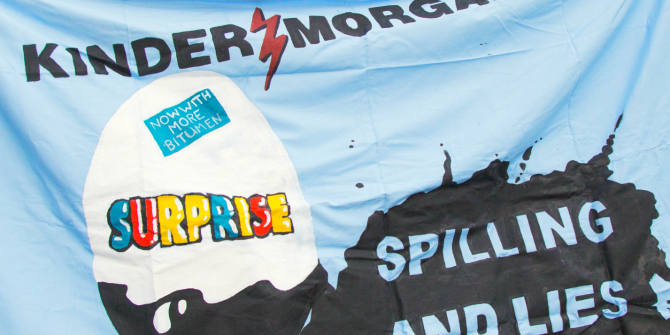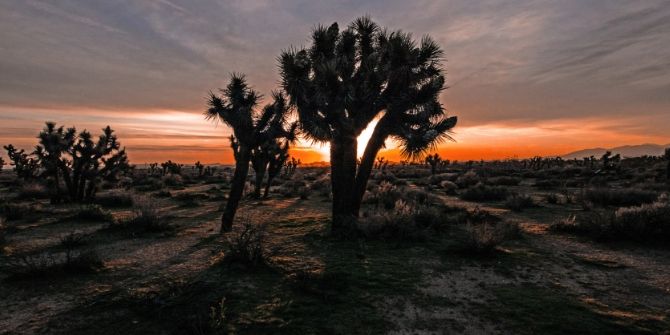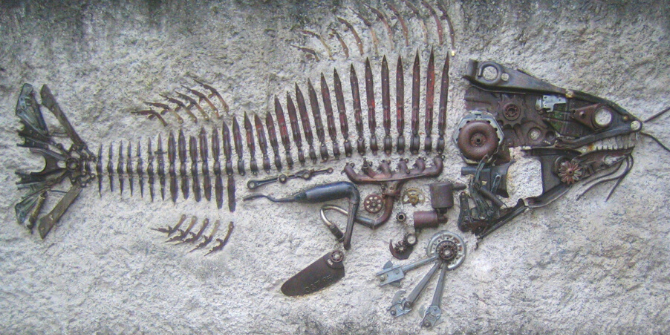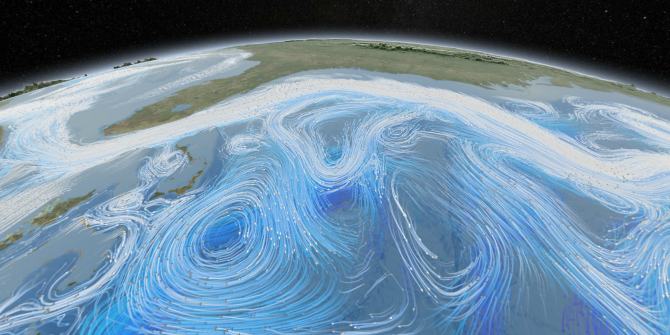In Bad Environmentalism: Irony and Irreverence in the Ecological Age, Nicole Seymour turns attention away from despair at climate change and environmental devastation to instead look at gestures and responses rooted in the comical, the silly and the ridiculous and their capacity to offer sites of resistance. This is a powerful example of humanities scholarship that makes a forceful intervention into pressing political and social issues, finds Frankie Hines.
Bad Environmentalism: Irony and Irreverence in the Ecological Age. Nicole Seymour. University of Minnesota Press. 2018.
 Find this book (affiliate link):
Find this book (affiliate link): ![]()
Efforts to address climate change sometimes seem to have the quality of a joke about them: lawmakers continue to put their fingers in their ears and pretend ecological devastation is a myth, while their well-meaning colleagues propose solutions that feel like rearranging the deckchairs on board the Titanic. Faced with this political picture, despair appears a reasonable response—but this, Nicole Seymour argues in Bad Environmentalism, is the wrong move. Instead, Seymour suggests, we should stay with the comical, the silly, the ridiculous, and find in those experiences possibilities for resistance.
The argument of Bad Environmentalism is that there is much to learn from environmental texts—books, film, television and performance art, among other forms—that employ ‘dissident, often-denigrated affects and sensibilities to reflect critically on both our current moment and mainstream environmental art, activism, and discourse’ (6). Where mainstream environmental texts such as Al Gore’s An Inconvenient Truth (2006) try to rouse readers and viewers to their cause through self-righteous appeals to guilt, shame and evocations of doom and gloom, the ‘bad environmentalism’ that Seymour describes finds more value in ‘irony, absurdity, perversity, and the like’ (11). Bad Environmentalism mostly finds these themes in what Seymour calls ‘low environmental culture’ (192), but its focus is not narrow: mainstream comedy films sit alongside readings of more highbrow contemporary poetry and nature writing. Seymour’s intention is not to show that these texts are in fact ‘good’ by the standards of high-minded environmentalists and ecocritics, but to explore what they offer by virtue of their ‘badness’.
Chapter One focuses on contemporary films across several genres to develop an argument about the politics of environmental knowledge. Here Seymour considers the contradictions of mainstream environmentalist texts like An Inconvenient Truth, which she convincingly criticises for its complacent approach to the gaps in knowledge that fuel climate change scepticism. Seymour finds more promising prospects in Hannes Lang’s documentary Peak (2011) and Mike Judge’s dystopian comedy Idiocracy (2006), each of which in quite different ways refuses to adopt the role of imparting correct knowledge, and instead casts doubt on the positive role of expertise, giving voice to the uncertainty and ambivalence that is a feature of most people’s understandings of climate change.
Image Credit: Crop of ‘Rally against Kinder Morgan oil pipeline on Burnaby Mountain’ by Mark Klotz licensed under CC BY 2.0.
The second chapter looks to the animal-themed Jackass spinoff Wildboyz (2003-2006) and Isabella Rossellini’s short film series Green Porno (2008-2009), in which Seymour finds a distinctively irreverent approach to wildlife programming. The refusal of expertise is present again here, but more important are the ways that Rossellini and Wildboyz circumvent nature programmes’ traditional awestruck approach to their subjects and the distance they imagine to exist between ‘the natural world’ and the viewer. Seymour engages in some depth here with the work of queer theorist Jack Halberstam on films like Dude, Where’s My Car? (2000) and Finding Nemo (2003)—instances of ‘low culture’ that have much to offer ‘high theory’—and her extension of Halberstam’s ideas into the realm of environmental writing and animal studies is especially convincing.
Chapter Three continues to centre the relationship between environmentalism and the politics of sexuality, and further develops the argument of Seymour’s first book Strange Natures (2013). The chapter looks at the Eggplant Faerie Players, a Tennessee-based performance troupe; the Lesbian National Parks and Services, a Canadian performance art project; and the New York-based activist collective Queers for the Climate. Seymour’s definition of the ‘queer’ is appropriately broad: it encompasses not only performances involving or depicting LGBTQ+ people, but also others that engage ‘with nature, environment, and the nonhuman “improperly” […] through modes such as gaiety and frivolity’ (115). Seymour here poses an important challenge to a strand of queer theory that rejects political projects that appeal to a better future, and asks ‘what’s so new or interesting about queers saying “fuck the future” […] if British Petroleum is saying it, too?’ (113).
The penultimate chapter continues to examine the intersections of environmentalism and other social and political phenomena, focusing here on ‘racialized environmental affect’ with reference to representations of Native Americans and African Americans in environmental literature by writers including LaTasha N. Nevada Diggs, Sherman Alexie and Percival Everett. The final chapter, meanwhile, turns its focus to matters of class and deals with a typically diverse range of sources: The Simpsons Movie (2007), Edward Abbey’s novel The Monkey Wrench Gang (1975), the documentary Goodbye Gauley Mountain (2013) and the sitcoms Kath & Kim (2002-2007) and The Goode Family (2009). Seymour’s reading of Abbey’s novel, which was among the first to bring ‘the bawdy and the body into environmental activism’ (210), is especially compelling, dealing in some depth with its characters’ responses to the contradictions between their environmentalism and their consumerism.
Given that Seymour acknowledges that her book is not comprehensive, and that it tries to offer ‘vivid examples’ rather than cataloguing every instance of bad environmentalism (7), it may be churlish to suggest areas where a greater degree of attention would benefit the study. Yet more sustained examination of environmental activism and its frequently carnivalesque, satirical or silly manifestations would be one such topic. The discussion of Queers for the Climate shines a light on one such activist group, but a great many others have used parodic or unserious protest repertoires in service of a number of causes, which have been accompanied by interventions in literature and film. I am thinking here of the various autobiographies and how-to guides written by participants in the Earth First! movement in the United States, or British films like Just Do It (2011) and Grasp the Nettle (2013), which stage environmental protest and direct action in the irreverent, exuberant style that Seymour celebrates.
On the whole though, the examples are well-selected and their juxtaposition convincingly makes the case that, as Seymour puts it: ‘To carry on in the face of climate change denial and bleak chances for success is both seemingly impossible and utterly necessary. It is also […] inherently, darkly ridiculous’ (145). The study’s theoretical grounding is also worthy of praise: the categories of irony, queerness and environmentalism are not used uncritically, and the discussion of affect in particular—a tricky concept used in a variety of ways across the humanities—is especially cogent and insightful (19–30). Seymour’s style is engaging and—appropriately—often humorous, such as when she introduces her account of irony with reference to Alanis Morissette’s famous misunderstanding of that concept (8), or wonders what the novelist and nature poet Wendell Berry might make of the invention of the selfie stick (15). Bad Environmentalism stands as an important example of the ways that humanities scholarship can make important interventions into issues of great political importance such as climate change, and will be of interest to students and scholars across several humanities disciplines (including but not limited to literature, media, gender and sexuality studies) who are interested in contemporary environmentalism and its vicissitudes.
Note: This review gives the views of the author, and not the position of the LSE Review of Books blog, or of the London School of Economics. The LSE RB blog may receive a small commission if you choose to make a purchase through the above Amazon affiliate link. This is entirely independent of the coverage of the book on LSE Review of Books.









2 Comments